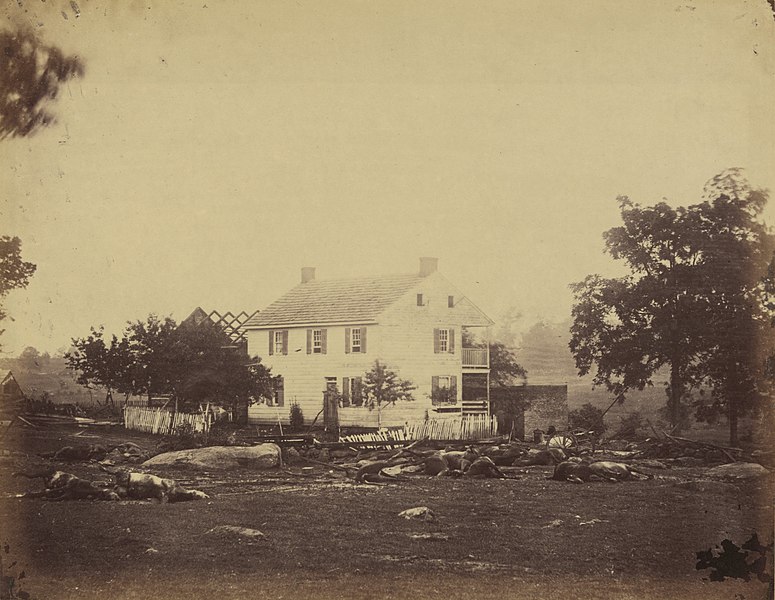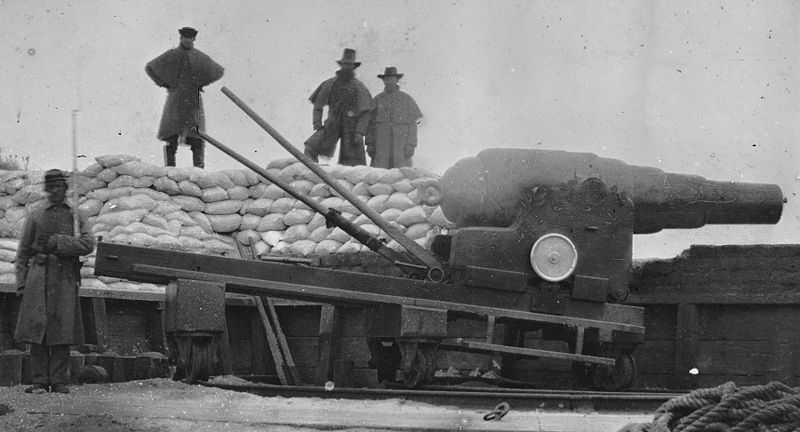.

Large group of slaves standing in front of buildings on J. J. Smith's Plantation, Beaufort, South Carolina, 1862 (Library of Congress)

Five generations on Smith's Plantation, Beaufort, South Carolina, 1862 (Library of Congress)

Plantation, Port Royal Island, South Carolina. Slaves quarters, April 1862 (Library of Congress)

Fort Pulaski, Georgia. The breach, 1862 (Library of Congress)

View from across the Rappahannock River in Fredericksburg, Virginia, February 1863 (Library of Congress)

Capt. George A. Custer and Gen. Alfred Pleasonton on horseback, Falmouth, Virginia, April 1863 (Library of Congress)

Confederate prisoners at Fairfax Court House, June 1863 (National Archives and Records Administration)

Trossell's House, Battle-Field of Gettysburg, July 1863: published in Gardner's Photographic Sketchbook of the War, Washington, D.C., 1865 (Library of Congress)

Battle-field of Gettysburg -- Dead Confederate sharpshooter [identified in attached clipping as Andrew Johnston Hoge] at foot of Little Round Top [i.e., Devil's Den], July 1863: published in Gardner's Photographic Sketchbook of the War, Washington, D.C., 1865 (Library of Congress)

Gettysburg, Pennsylvania. "Slaughter pen" on left wing, at foot of [Little] Round Top, July 1863: published in Gardner's Photographic Sketchbook of the War, Washington, D.C., 1865 (Library of Congress)

A Harvest of Death, Gettysburg, July 1863: published in Gardner's Photographic Sketch Book of the War, Washington, D.C.,1865 (Library of Congress)

Gettysburg, Pennsylvania. Bodies of Confederate soldiers killed on 1 July 1863, near the McPherson woods (Library of Congress)

Gettysburg, Pennsylvania. Confederate dead gathered for burial at the southwestern edge of the Rose woods, 5 July 1863 (Library of Congress)

American Civil War. The "Pulpit" after capture, Fort Fisher, North Carolina, January 1865 (U.S. Army)

Fort Fisher, North Carolina. Interior view. English 8-inch Armstrong gun, 1865 (Library of Congress)

Appomattox Court House, Virginia. Federal soldiers at the courthouse, April 1865 (Library of Congress)



5 comments:
Tom,
Amazing pictures, a lesson in history -- Johnny says "Thank you Tom". . . .
8.18
light coming into fog against invisible
ridge, towhee disappearing above branch
in foreground, sound of wave in channel
something may arrive at and
fall into, “oblivion”
a point, in an extended way,
in what is most to be
grey white of fog reflected in channel,
circular green pine on tip of sandspit
Fucking awful. I hate seeing photographs depicting the aftermath of battles. It's all so pointless. Whichever way the hammer falls life wouldn't really be that different as it pans out over time. We're just substituting one hierarchy for another. We vote our own tyrants in - and then end up fighting wars for them.
I'm reminded of the comment (which surprised many) made by Andrew Marvell, in his years as a Parliamentarian, after the contentions of that particular civil war had begun to fade away, that men might have and indeed ought to have let events take their course as they would, for, as Marvell suggested, they were going to come out that way anyway, and none the swifter for men's attempts at driving them along.
Andrew Marvell should perhaps have stuck to politics. He's in my list as one of the worst poets of his era.
Yes, he was wonderful at politics. Once, in the midst of a heated debate in the House, a particularly noisome adversary was descending the steps to speak... and our Andrew discreetly stuck out a toe and tript him.
It was rumoured that he kept bottles within his chambers, that he was gay, and so on.
He had no interest in being a celebrity or in having his private life sorted out in public.
He also kept his poetry close, and never published a book of it in his lifetime.
He rates at the top of my list of the poets of that or indeed any era.
(Open and diametric respectful disagreement with our good friends remains one of the few pleasures in life. Though I suppose we ought not be tripping them on the steps.)
Post a Comment